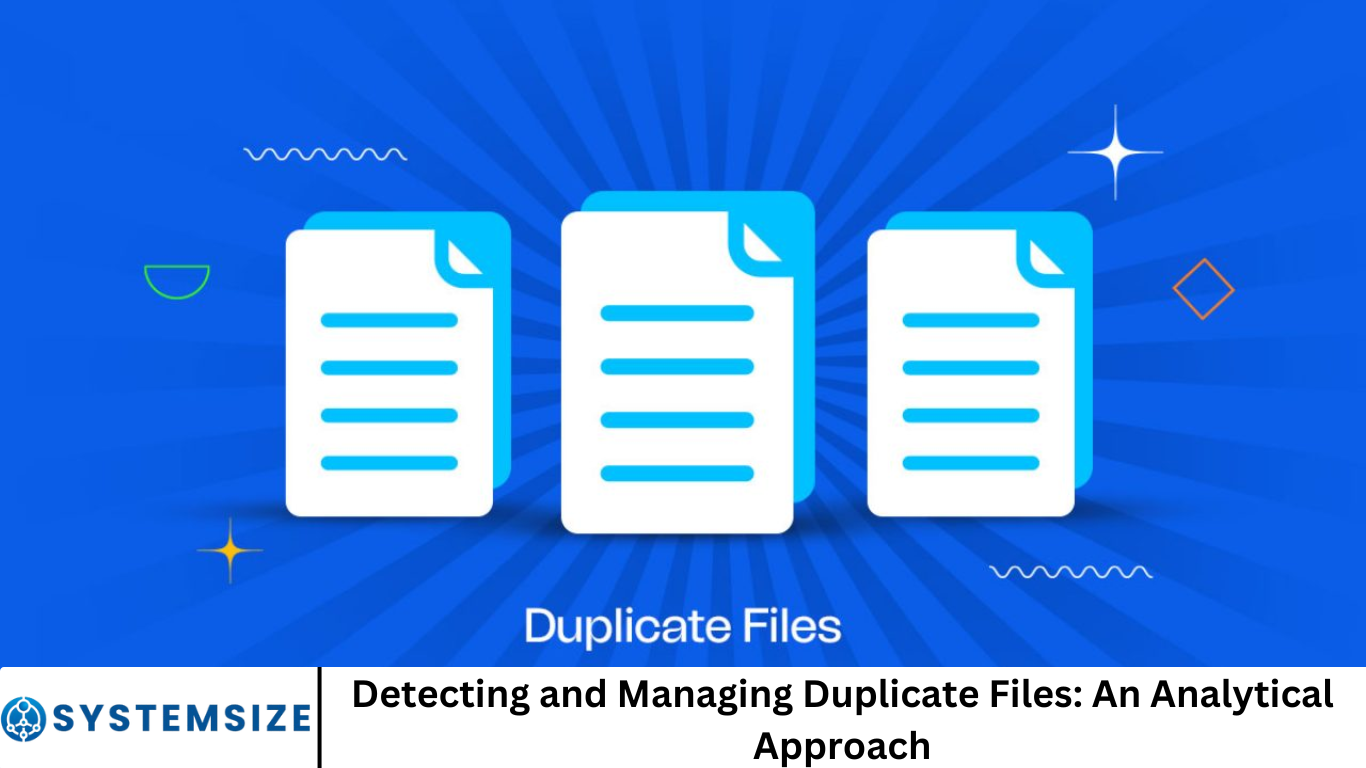Duplicate files are a hidden menace across computing environments—from desktops and corporate servers to cloud storage and NAS devices. They waste disk space, complicate backup procedures, slow down searches, and—even worse—pose security risks by increasing attack surfaces.
In this article, we explore detecting and managing duplicate files, taking an analytical approach to help businesses, IT staff, and individuals optimize storage, improve performance, and enhance data hygiene.
More Read: Eliminate Duplicate Files: The Ultimate Guide to a Clutter-Free Device
What Are Duplicate Files?
- Definition: Files that have identical or near-identical content but reside separately.
- Types of duplicates:
- Exact byte-for-byte copies, e.g., cloned files, backup archives.
- Near-duplicates, such as re-saved documents with minor edits or images with different metadata.
- Common sources: backups, cloud syncs (e.g., Dropbox, Google Drive), downloaded versions, migrated folders, system-based fragmentation.
Why Duplicates Are a Problem
- 1. Storage waste: Accumulated copies can consume significant disk space.
- 2. Inefficient backups: Backing up the same content multiple times is redundant and time-consuming.
- 3. Performance degradation: File search, indexing, and defragmentation slow down.
- 4. Data integrity confusion: Redundant versions lead to version control chaos.
- 5. Security & compliance risks: Sensitive data may be duplicated in unsecured places, increasing exposure.
SEO tip: include internal links here, e.g., “Learn more about data backup best practices.”
Analytical Overview of File Deduplication
Metrics for Analysis
- Duplication rate (% of duplicate bytes divided by total storage).
- File type distribution (e.g., documents, images, media, executables).
- Location hotspots (e.g., Downloads, Desktop, Cloud folders).
- Access frequency stats (are duplicates actively used?).
- User behavior patterns (who creates duplicates and how?).
Methodologies
- Hash-based detection (MD5, SHA-1, SHA-256): Reliable for spotting exact copies.
- Binary comparison: Confirms duplicates byte by byte.
- Metadata & fuzzy techniques: Matches by file name, size, date, or visual similarity (especially for images).
- Content scanning (text similarity): Analyzes document similarity using shingling/indexing.
Detecting Duplicate Files: Step-by-Step
Step 1: Planning & Scoping
- Decide on directories to analyze.
- Define acceptable duplicate types (exact, near-duplicate, visual duplicates).
- Clarify acceptable risk and resource overhead.
Step 2: Tool Selection
Popular tools include:
- Open-source:
- rmlint (Linux)
- fdupes (cross-platform)
- dupeGuru (Windows/macOS/Linux, supports fuzzy detection)
- Commercial:
- CCleaner, AllDup, Duplicate Cleaner Pro, enterprise storage deduplication solutions.
Step 3: Running Scans
- Use hash-based scanning for exact duplicates.
- Supplement with fuzzy image or document comparison.
- Export scan reports listing duplicate sets, file size, path, last-modified dates.
Step 4: Validation & Verification
- Spot-check duplicates before deletion.
- Prioritize older or less-accessed files.
- Decide whether to consolidate copies (e.g., use symlinks) or archive them.
Managing Duplicate Files
Automated vs Manual Handling
- Automated tools can mass-delete or archive duplicates but carry risk.
- Manual review is safer for key directories or critical systems.
Consolidation Techniques
- Hard links/Symbolic links on filesystems like NTFS and ext4.
- Archiving less active duplicates (zip, tar) and storing them in cold archives.
- Cloud deduplication features automatically minimize redundant data (e.g., Ondisk dedupe, Amazon S3 intelligent tiering).
Integrating Into Backup Strategies
- Pre-backup scans eliminate duplicates in daily routines.
- Deduplication-aware backup tools only store unique segments (e.g., Veeam, Commvault).
- Get versions management to avoid redundant shadow copies.
Scheduling & Automation
- Periodic automated scans during low-load periods.
- Clean logs, evaluate duplicates, and archive or delete.
- Alerts notify system administrators about high duplication levels.
Security Implications of Duplicate Files
- Expanded attack surface: Duplicated sensitive files are easier targets if not all copies are secured.
- Compliance risk: GDPR, HIPAA, etc.—if a single sensitive record exists in 3 same-form files across servers, each counts.
- Revision drift: Inadvertent sharing of outdated duplicates can lead to outdated or insecure data dissemination.
Best practice: Incorporate duplicate detection into security audits. Encrypt duplicates or delete lower-value ones.
Case Study: Enterprise-Level Deduplication
- A mid-sized company with 250 TB storage accumulated 50 TB of duplicates across file shares.
- Deployed file integrity scan & dedupe tool.
- Identified 10 % duplication.
- Removed archives via automated policy.
- Converted remaining duplicates to hard links.
- Achieved 20 % storage savings, 30 % faster backups, and reduced support tickets on duplicate confusion.
(This is a hypothetical but relatable case.)
Tools & Techniques Overview
| Tool / Technique | Platform(s) | Strengths | Notes |
|---|---|---|---|
| rmlint | Linux | Fast, scriptable, handles hard-linking | CLI-based, steep learning curve |
| fdupes | Windows/Linux | Simple, MD5/SHA-based scanning | May be slow with large datasets |
| dupeGuru | W/M/L/X | GUI, supports fuzzy and image matching | Ideal for mixed media directories |
| Enterprise dedupe (e.g., CommVault) | Cross-platform | Transparent dedupe at file-block level | Higher implementation cost |
Best Practices & Tips
- Always back up before purging duplicates.
- Run “dry runs” to view potential deletions.
- Start small: Begin with Downloads and temp folders.
- Enable version control to preserve audit trails.
- Communicate changes to users to ensure trust in automation.
- Monitor duplication metrics and set thresholds for alerting IT teams.
Future Trends & Emerging Tech
- AI-powered deduplication: Analyzing document semantics, images, video frames to detect near-duplicates.
- Blockchain-based integrity checks: Proof-of-uniqueness records using hash anchoring.
- Edge-device dedupe: On-device scanning before sync to reduce network usage.
- Global reference pointers: Decentralized dedupe across hybrid clouds tracking by content ID.
Frequently Asked Question
What are the most effective methods for detecting duplicate files?
The most effective methods include hash-based comparison (using MD5, SHA-1, etc.) for exact duplicates, byte-by-byte comparison for verification, and metadata or fuzzy matching for near-duplicates. Tools like dupeGuru, fdupes, and enterprise deduplication systems use these methods in combination.
Why is it important to manage duplicate files?
Managing duplicate files helps to save storage space, improve system performance, reduce backup times, and minimize security risks. It also supports better data organization and ensures compliance with data governance standards.
Can duplicate file detection be automated?
Yes. Many tools and scripts allow you to schedule duplicate scans, auto-delete or archive duplicates, and generate reports. However, automated deletion should be used cautiously and preferably combined with a manual verification step.
What are the risks of deleting duplicate files?
Risks include accidentally removing the wrong version, breaking links or dependencies, and losing important metadata. Always back up data, review files manually, or use soft deletion techniques like archiving or moving to quarantine folders.
How do duplicate files affect cloud storage?
Duplicate files consume additional bandwidth and storage, leading to increased costs and longer sync times. Some cloud systems offer built-in deduplication, but local deduplication before uploading is more efficient and under your control.
What role does deduplication play in data security?
By reducing the number of file copies, deduplication lowers the attack surface, simplifies access control, and prevents outdated or insecure copies from circulating. It also aids in compliance with data privacy laws like GDPR and HIPAA.
Are there different strategies for exact vs. near-duplicate files?
Yes. Exact duplicates can be confidently deleted or replaced with hard links. Near-duplicates require deeper analysis—content comparison, version control, or user input—to determine which versions to keep or merge.
Conclusion
Detecting and managing duplicate files is essential for efficient, secure, and optimized digital environments. By using an analytical approach—measuring duplication, deploying robust tools, validating with care, and integrating dedupe in standard workflows—organizations and individuals can enhance storage utilization, streamline operations, and reduce risks.


